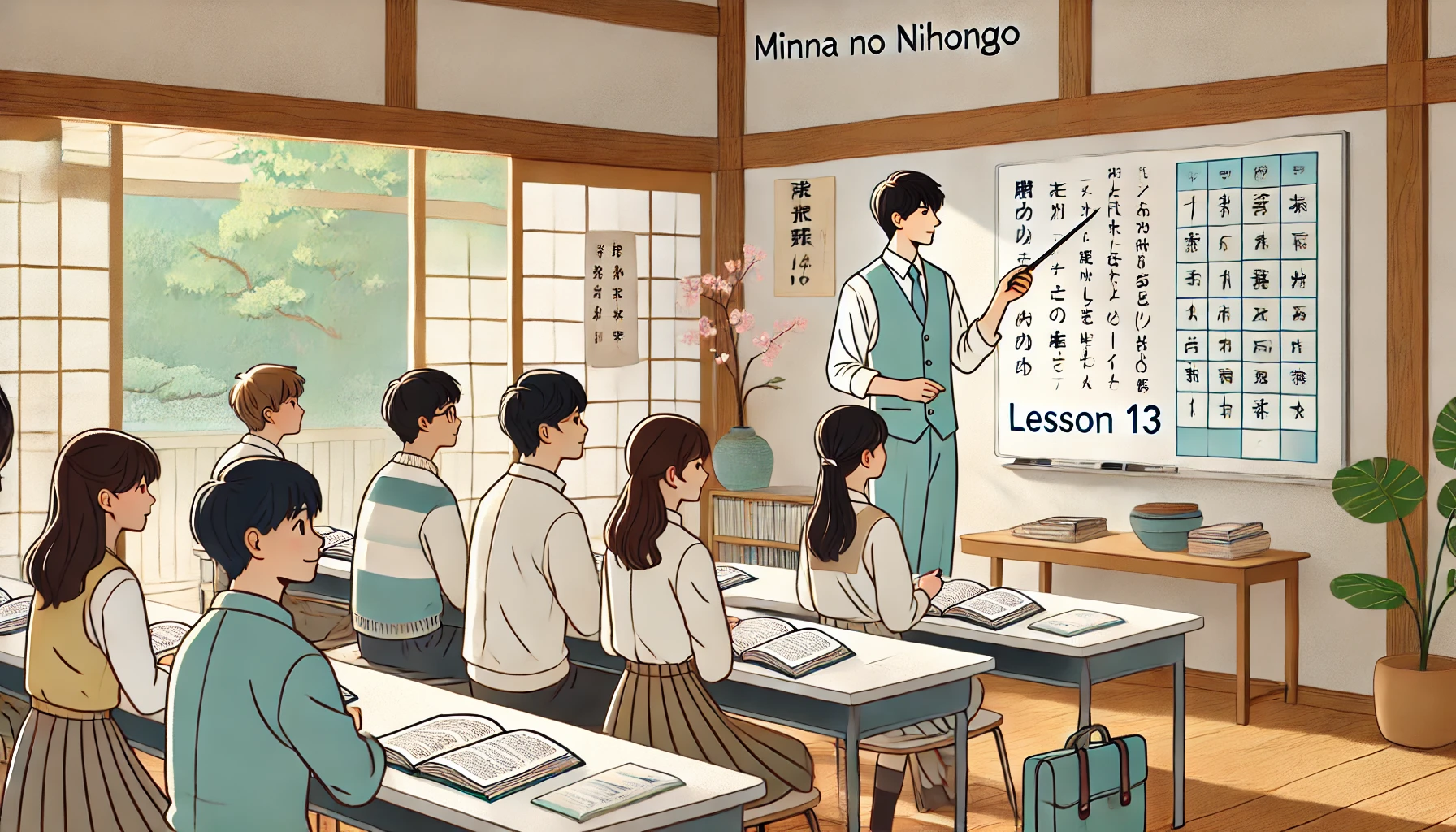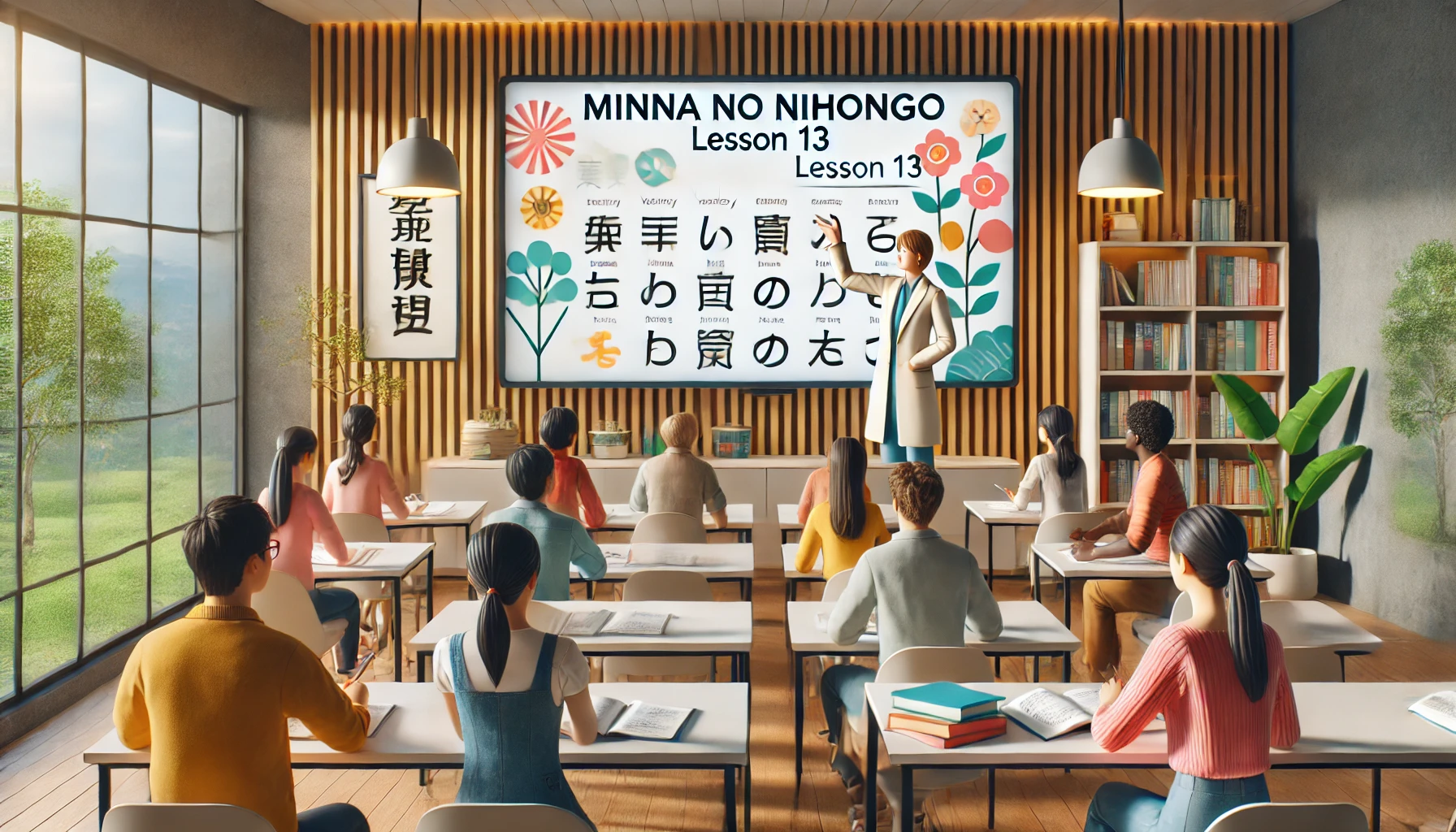Minna no Nihongo Lesson 13 Vocabulary: Minna no Nihongo, one of the most popular Japanese language textbooks, has helped countless learners master the fundamentals of Japanese. Lesson 13 in this series stands out as a critical chapter, focusing on vocabulary essential for everyday communication. Whether you’re preparing for an exam or just looking to enhance your conversational skills, mastering this lesson’s vocabulary is a must.
Read Also: Minna no Nihongo Lesson 12 Vocabulary
Minna no Nihongo Lesson 13 Vocabulary Practice
| Japanese (Kanji) | Japanese (Kana) | English Translation | Vietnamese Translation | Bahasa Indonesia Translation | |
|---|---|---|---|---|---|
| 遊びます | あそびます | To play, enjoy oneself | Chơi, giải trí | Bermain | |
| 泳ぎます | およぎます | To swim | Bơi | Berenang | |
| 迎えます | むかえます | To welcome, meet | Đón | Menyambut | |
| 疲れます | つかれます | To get tired | Mệt | Lelah | |
| 出します | だします | To send (a letter) | Gửi (thư) | Mengirim (surat) | |
| 入ります | はいります | To enter (a place) | Vào | Masuk | |
| 出ます | でます | To go out, leave | Ra, rời khỏi | Keluar | |
| 買い物します | かいものします | To shop, do shopping | Mua sắm | Berbelanja | |
| 食事します | しょくじします | To have a meal | Ăn uống | Makan | |
| 散歩します | さんぽします | To take a walk | Đi dạo | Berjalan-jalan | |
| 大変 (な) | たいへん (な) | Tough, hard | Vất vả, khó khăn | Sulit | |
| 欲しい | ほしい | To want (something) | Muốn | Ingin | |
| 寂しい | さびしい | Lonely | Cô đơn | Kesepian | |
| 広い | ひろい | Wide, spacious | Rộng | Luas | |
| 狭い | せまい | Narrow, small (space) | Hẹp | Sempit | |
| 市役所 | しやくしょ | City hall | Tòa thị chính | Balai kota | |
| プール | プール | Pool | Hồ bơi | Kolam renang | |
| 川 | かわ | River | Con sông | Sungai | |
| 経済 | けいざい | Economy | Kinh tế | Ekonomi | |
| 美術 | びじゅつ | Fine arts | Mỹ thuật | Seni rupa | |
| 釣り | つり | Fishing | Câu cá | Memancing | |
| 会議 | かいぎ | Meeting, conference | Cuộc họp | Rapat | |
| 登録 | とうろく | Registration | Đăng ký | Pendaftaran | |
| 週末 | しゅうまつ | Weekend | Cuối tuần | Akhir pekan | |
| ~ごろ | ~ごろ | Around ~ (time) | Khoảng ~ (thời gian) | Sekitar ~ (waktu) | |
| 何か | なにか | Something | Cái gì đó | Sesuatu | |
| どこか | どこか | Somewhere | Nơi nào đó | Suatu tempat |
Grammar Points for Minna no Nihongo Lesson 13
1. ~たいです (Want to Do Something)
This is used to express a desire to do something.
Formation:
- Verb (ます form) + たいです
Examples:
- 日本へ行きたいです。
(I want to go to Japan.) - 寿司を食べたいです。
(I want to eat sushi.) - 海で泳ぎたいです。
(I want to swim in the sea.) - 友達と遊びたいです。
(I want to play with my friends.)

2. ~へ ~に行きます (Go to a Place for an Activity)
This is used to express going somewhere to do a specific activity.
Formation:
- Place + へ + Verb (ます form) + に行きます
Examples:
- 図書館へ本を借りに行きます。
(I am going to the library to borrow books.) - スーパーへ買い物に行きます。
(I am going to the supermarket to shop.) - 公園へ散歩に行きます。
(I am going to the park to take a walk.) - 海へ泳ぎに行きます。
(I am going to the sea to swim.)
3. ~がほしいです (Want Something)
This is used to express a desire for something.
Formation:
- Noun + がほしいです
Examples:
- 新しいパソコンがほしいです。
(I want a new computer.) - 車がほしいです。
(I want a car.) - きれいなカメラがほしいです。
(I want a nice camera.) - 日本のお土産がほしいです。
(I want a souvenir from Japan.)
4. ~てから (After Doing Something)
This is used to describe an action that is performed after completing another action.
Formation:
- Verb (て-form) + から
Examples:
- 朝ごはんを食べてから学校へ行きます。
(I go to school after eating breakfast.) - 宿題をしてからテレビを見ます。
(I watch TV after doing my homework.) - 手を洗ってからご飯を食べます。
(I eat after washing my hands.) - 運動してからシャワーを浴びます。
(I take a shower after exercising.)
Worksheet for Minna no Nihongo Lesson 13
Part 1: Vocabulary Practice
A. Fill in the blanks with the correct vocabulary word:
- I want to play at the park. 公園で ______ たいです。
- She goes to the supermarket to shop. 彼女はスーパーへ ______ に行きます。
- I get tired after a long walk. 長い散歩の後で、私は ______ ます。
- What do you want? 何が ______ ですか?
- I want to eat sushi. 寿司を ______ たいです。
B. Match the word with its meaning:
| Japanese | English |
|---|---|
| 疲れます | A. Registration |
| 登録 | B. Lonely |
| 欲しい | C. To get tired |
| 寂しい | D. To want |
| 散歩します | E. To take a walk |
Part 2: Grammar Practice
A. Translate the following sentences into Japanese:
- I want a new car.
- We go to the library to study.
- She goes to the park to take a walk.
- After eating breakfast, I go to work.
B. Rewrite using ~たいです:
- 食事します。(to eat)
- 泳ぎます。(to swim)
- 登録します。(to register)
Part 3: Sentence Building
A. Make sentences using the following grammar patterns:
- ~たいです: (Example: I want to travel to Japan.)
- ~へ ~に行きます: (Example: I go to the river to fish.)
- ~がほしいです: (Example: I want a beautiful house.)
- ~てから: (Example: I read a book after cleaning my room.)
Key Grammar Points
- ~たいです: Use to express what you want to do. Attach it to the ます-form of a verb.
- Example: 日本へ行きたいです。(I want to go to Japan.)
- ~へ ~に行きます: Use to describe going somewhere for a purpose.
- Example: スーパーへ買い物に行きます。(I am going to the supermarket to shop.)
- ~がほしいです: Use to express a desire for something.
- Example: 車がほしいです。(I want a car.)
- ~てから: Used to describe an action performed after another.
- Example: 宿題をしてからテレビを見ます。(I watch TV after doing my homework.)

Tips to Remember Vocabulary and Grammar
- Break It Down: Learn words in small chunks, such as related to actions (遊びます, 泳ぎます) or locations (図書館, 市役所).
- Visualize: Pair vocabulary with images. For example, imagine a river when you learn 川 (river).
- Practice Context: Use sentences instead of isolated words. Example: 友達と遊びたいです。(I want to play with my friends.)
- Mnemonic Devices:
- 欲しい (ほしい): Think of “HOpe to have it” to remember it means “to want.”
- 寂しい (さびしい): Sounds like “sad and lonely.”
- Regular Review: Revisit vocabulary and grammar points daily to strengthen memory.
Conclusion
Mastering Minna no Nihongo Lesson 13 vocabulary opens doors to smoother communication and deeper cultural understanding. Make it a point to practice regularly, engage with native speakers, and utilize helpful resources to excel.
FAQs
What does Lesson 13 in Minna no Nihongo cover?
It focuses on vocabulary related to daily life, including verbs, adjectives, and nouns.
How can I effectively memorize new vocabulary?
Use mnemonic devices, create flashcards, and practice with native speakers.
Are there apps that focus on Minna no Nihongo vocabulary?
Yes, apps like Anki and Memrise are excellent for spaced repetition practice.
How does Lesson 13 vocabulary help in daily conversations?
It introduces essential phrases and expressions for common situations.
Can I skip some lessons and still learn Japanese effectively?
Skipping lessons can create gaps in understanding. It’s best to follow the sequence for comprehensive learning.